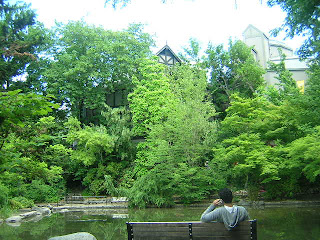

2008 was a banner year for me in my garden. Last summer our friendly garbage and recycling company announced the beginning of the long-awaited curbside pickup of yard debris. For a small monthly fee, they offered to deliver a handsome blue container and begin biweekly removal of organic garden waste. I can't tell you what a thrill this was for me.
For most of my 37 years of gardening, during which time I have spent countless hours, or probably years by now, of my life weeding, I have had nowhere to put the resulting mountains of debris. Alas, I'm not talking about the innocent early green sprouts of annual weeds and the odd patch of naughty volunteer grass that can go right into the compost pile to join the kitchen scraps and spent peavines later in the summer. I'm talking about Evil Weeds, ie weeds that have escaped my attentions long enough to set seeds and become a menace to the future of my garden. I am sorry to say this has happened a lot in my decades of gardening. And the wages of garden slacking is definitely a lot more weeds.
Due to my patented laissez (pronounced lazy) faire style of composting, ie 'stick everything in the composter and ignore it for a couple of years', my compost never gets hot enough to reliably break down weed seeds, so putting weeds with already-set seeds into the mix merely spreads a gazillion uncomposted weed seeds to every corner of the yard, thus creating more work for the foreseeable future, on into my twilight years.
To prevent this, up until last year I have resorted to simply piling the dangerous weed carcasses somewhere, anywhere, to sit and molder away, oftentimes over 3/4 of the growing season, until I could borrow a pickup truck from a friend and get it to the landfill, which operates a composting operation for people like myself. They grind up homeownerly pine needles, grass clippings, tree branches and the like (Ned's weeds) and produce several grades of compost which they sell back for civic soil enhancement. A fine gardening resource in a place with soil that could more accurately titled 'sand'.
Admittedly, this annual pilgrimage to the landfill had its enjoyable side, since it entailed recruiting my noble mate for a full day of middle-aged fun. In case there are younger readers here, let me describe for you a typical
Romantic Date for the Longtime Married Couple 1. Drive together to the home of the truck loaner. Leave our wee car there and drive back home.
2. Load truck. (Translation: pack the bed of the pickup with a huge stack of scratchy, smelly, stickery, thorny, disgusting, wet, dusty, recalcitrant, sproingy, crackly, etc woody Stuff, jumping up and down to get as much in as humanly possible; cover with whatever UBT(Ubiquitous Blue Tarp) we can find that isn't already in use covering a woodpile, tie it all down with a motley assortment of bungies & nylon cord.
3. Drive carefully to the landfill, keeping an eye on the rear view mirrors for escaping bits. In the early years, we often had to also drive while praying, since the trucks we borrowed tended to lack such luxuries as speedometers, one or more turn signals, brakes, gear shift knob, clutch, etc. And because our borrowed trucks usually belonged to bachelor guys, the cabs were always full of empty soda (or beer) cans, candy bar wrappers, magazines, string, tools, instruction manuals, work gloves, spare flannel shirts, parts for unidentifiable mechanical objects, rags, old newspapers, and an assortment of mystery items, all of this covered with a thick layer of ..... well, grunge.
4. Unload truck, keeping an envious eye on other landfill patrons, clearly depositing a mere one day's raking-worth of nice, lightweight pine needles, from the bed of a tidy little trailer, or spanking-new gargantuan behemoth pickup.
5. Return home and repeat, as many times as necessary to get rid of the whole pile.
6. On the way home from the last load, (here's where it gets really romantic) stop at the Pilot Butte Drive-Inn for giant burgers and a peanut-butter/chocolate milkshake. Yeah!
7. Return to friend's house, stopping on the way to put $10 worth of gas in the truck's gas tank, and arrive back home to the satisfying sight of a gone weed pile!
8. Take showers and start accruing the next year's landfill fodder. Sigh.
But now!!!!!!!! no more borrowing of trucks! no more trips to the landfill! no more martyred sweethearts! and no more debris piles! I simply fill my lovely blue bin and every other week, the big white truck comes and empties it. This has been so inspiring, in fact, that a few weeks after the first bin was delivered, I went hog wild and ordered a SECOND yard debris container. The infrequent landfill expeditions really only took the top off of my weed removal needs for all those years, and I had been holding back on a lot of needed cleanup because of nowhere to store the output.
One year later, I still manage to easily fill my beloved garden waste companions, dubbed Bruce and Betty Bin, shown in all their proud glory in the formal studio portrait above. The lower photo shows one of my garden beds, which has been choked with grass and other weeds for the last 5 years, and which now, thanks to the faithful service of the Bin family, is clear, raked smooth and ready for planting. Oh, the joy of bin-ness!










